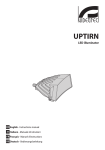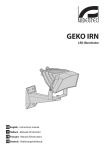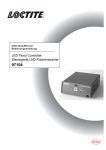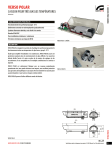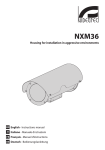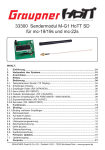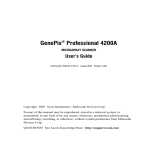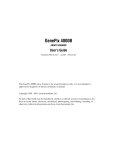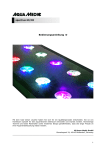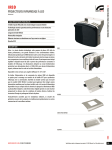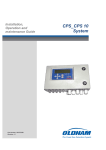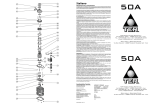Download GEKO IRH - SANTEC Video
Transcript
GEKO IRH LED illuminator EN English - Instructions manual IT Italiano - Manuale di istruzioni FR Français - Manuel d’instructions DE Deutsch - Bedienungslanleitung GEKO IRH LED illuminator EN English - Instructions manual Contents ENGLISH 1 About this manual.......................................................................................................... 3 1.1 Typographical conventions................................................................................................................................... 3 2 Notes on copyright and information on trademarks................................................... 3 3 Safety rules..................................................................................................................... 3 4 Identification................................................................................................................... 4 4.1 Product description and type designation..................................................................................................... 4 4.2 Product markings..................................................................................................................................................... 4 5 Declaration of conformity to product standards......................................................... 4 6 Preparing the product for use....................................................................................... 5 6.1 Unpacking and contents........................................................................................................................................ 5 6.1.1 Unpacking................................................................................................................................................................................... 5 6.1.2 Contents....................................................................................................................................................................................... 5 6.2 Safely disposing of packaging material............................................................................................................ 5 7 Assembling and installing............................................................................................. 5 7.1 Assembly...................................................................................................................................................................... 5 7.2 Installation................................................................................................................................................................... 5 7.2.1 Installation of wall-mounted illuminator......................................................................................................................... 5 7.2.2 Installation of housing-fitted illuminator (OSUPPIR kit)............................................................................................. 6 7.2.3 Connections............................................................................................................................................................................... 6 7.2.4 Photocell sensitivity................................................................................................................................................................. 7 7.2.5 Disabling the photocell.......................................................................................................................................................... 7 7.2.6 Power and control cable........................................................................................................................................................ 7 7.2.7 Maximum cable length.......................................................................................................................................................... 8 8 Disposal of waste materials........................................................................................... 8 9 Troubleshooting............................................................................................................. 8 9.1 Checking the power supply.................................................................................................................................. 8 9.2 Checking the photocell’s operation................................................................................................................... 8 10 Technical data............................................................................................................... 9 10.1 General..................................................................................................................................................................... 9 10.2 Mechanical.............................................................................................................................................................. 9 10.3 Electrical................................................................................................................................................................... 9 10.4 Environment........................................................................................................................................................... 9 10.5 Certifications........................................................................................................................................................... 9 11 Technical drawings..................................................................................................... 10 1 About this manual 3 Safety rules Do not stare at the lamp when on. It can be harmful for eyes. 1.1 Typographical conventions The products emits infrared light. Use suitable shielding or protect the eyes. DANGER! Emission of infrared light or laser. It can be harmful for eyes. Pay attention to the provided indications. DANGER! High level hazard. Risk of electric shock. Disconnect the power supply before proceeding with any operation, unless indicated otherwise. RISK GROUP 2 CAUTION: Do not look at operating lamp. Eye injury may result. NOTICE: IR emitted from this product. Use appropriate shielding or eye protection. Fig. 1 DANGER! Hot surface. Avoid contact. Surfaces are hot and may cause personal injury if touched. WARNING! Medium level hazard. This operation is very important for the system to function properly. Please read the procedure described very carefully and carry it out as instructed. INFO Description of system specifications. We recommend reading this part carefully in order to understand the subsequent stages. 2 Notes on copyright and information on trademarks The quoted names of products or companies are trademarks or registered trademarks. Instructions manual - English - EN Before installing and using this unit, please read this manual carefully. Be sure to keep it handy for later reference. Infrared illuminator. RISK GROUP 2 CAUTION: Do not look at operating lamp. Eye injury may result. CAUTION: Do not stare at operating lamp. May be harmful to the eyes. Fig. 2 White light illuminator. During normal operation the surface of the illuminator can reach high temperatures. Do not, therefore, allow direct contact and position the appliance where it is inaccessible to unauthorised persons. Before touching switch off the illuminator and allow to cool for a minimum period of 10 minutes. The manufacturer declines all responsibility for any damage caused by an improper use of the appliances mentioned in this manual. Furthermore, the manufacturer reserves the right to modify its contents without any prior notice. The documentation contained in this manual has been collected with great care, the manufacturer, however, cannot take any liability for its use. The same thing can be said for any person or company involved in the creation and production of this manual. 3 EN - English - Instructions manual • The device must be installed only and exclusively by qualified technical personnel. 4 Identification • Before any technical work on the appliance, disconnect the power supply. 4.1 Product description and type designation • Do not use power supply cables that seem worn or old. • Never, under any circumstances, make any changes or connections that are not shown in this handbook: improper use of the appliance can cause serious hazards, risking the safety of personnel and of the installation. • Use only original spare parts. Non-original spare parts could cause fire, electrical discharge or other hazards. • Before proceeding with installation check the supplied material to make sure it corresponds to the order specification by examining the identification labels (4.2 Product markings, page 4). State of the art illuminator, which provides high reliability and excellent image quality. The GEKO lights the entire scene evenly, eliminating hotspots and underexposures, for unbeatable night-time images and secure surveillance of the area. The high efficiency heat sink body ensures maximum LED durability and protection against over-temperatures, whereas the front glass, made of special technopolymer, provides high infrared transmittance (transparent glass in the white light version). The GEKO illuminators are protected against electrostatic discharges. These illuminators incorporate a circuit that allows them to be powered directly from a 12-24Vdc or 24Vac supply. A weatherproof box with 230Vac or 120Vac power supply is available as accessory for one or two GEKO illuminators. GEKO is supplied with a wall-mount bracket that rotates horizontally and vertically and can be assembled in a housing by means of the OSUPPIR bracket. 4.2 Product markings See the label attached to the outside of the package. 5 Declaration of conformity to product standards This is a Class A product. In a domestic environment this product may cause radio interference. In this case the user may be required to take adequate measures. • Electrical safety: EN60598 • Safety of laser products: EN60825-1 • Electromagnetic compatibility: EN55022, Class A • Immunity: EN50130-4 • FCC Part 15, Class A 4 7 Assembling and installing During normal operation the surface of the illuminator can reach high temperatures. Do not, therefore, allow direct contact and position the appliance where it is inaccessible to unauthorised persons. Before touching switch off the illuminator and allow to cool for a minimum period of 10 minutes. Any change that is not expressly approved by the manufacturer will invalidate the guarantee. 6.1 Unpacking and contents 6.1.1 Unpacking Do not stare directly into the lamp at a distance of less than 1.7m (5.6ft). When the product is delivered, make sure that the package is intact and that there are no signs that it has been dropped or scratched. The assembly and installation must be performed only by skilled personnel. If there are obvious signs of damage, contact the supplier immediately. Keep the packaging in case you need to send the product for repairs. 7.1 Assembly 6.1.2 Contents Fasten the top bracket (01) to the lamp using the screws and washers (02) supplied. Check the contents to make sure they correspond with the list of materials as below: 01 • Illuminator with bracket • Wall-fastening bracket 02 • Instructions manual 6.2 Safely disposing of packaging material The packaging material can all be recycled. The installer technician will be responsible for separating the material for disposal, and in any case for compliance with the legislation in force where the device is to be used. When returning a faulty product we recommend using the original packaging for shipping. 02 Fig. 3 7.2 Installation 7.2.1 Installation of wall-mounted illuminator The illuminator’s position can be decided at the time of installation. Fig. 4 5 Instructions manual - English - EN 6 Preparing the product for use EN - English - Instructions manual Fasten the bracket as shown in the figure. Drive the wall screws in tight. 7.2.2 Installation of housing-fitted illuminator (OSUPPIR kit) Fasten the plate (01) between the bottom of the housing (02) and the bracket (03) using the screws supplied (04). Fig. 5 Fasten the illuminator, complete with its bracket, using the screw, the nut and the washer supplied. 03 02 01 04 Fig. 8 Fasten the illuminator (complete with its bracket) using the nut and the washer. Fig. 6 Set the illuminator’s vertical and horizontal inclination by adjusting the two fastening screws. Fig. 9 Set the vertical and horizontal inclination (Fig. 7, page 6). Fig. 7 Check the resulting illumination range on the screen.Tighten all the screws. Check the resulting illumination range on the screen. Tighten all the screws. 7.2.3 Connections Power supply and control Fig. 10 6 Photocell Switch-on threshold regulator 7.2.5 Disabling the photocell The photocell is set in the factory at a predetermined luminous level, suitable for most installations (approximately 50Lux). In the event the intervention threshold (illuminator activation) must be adjusted differently, loosen the plug on the illuminator rear and proceed adjusting. To disable the lamp’s automatic switch-on set the brightness to minimum (turn the potentiometer all the way anticlockwise). With this setting the lamp can only be switched on by closing the telemetry contact, if the system is equipped with a central dusk switch or a remote-controlled contact. Using a Phillips screwdriver, turn the trimmer anticlockwise to make the illuminator switch on in low brightness conditions or clockwise to make it switch on in better brightness conditions. 7.2.6 Power and control cable The illuminator is supplied with a 2m (6.6ft) long power and control cord. Power cables, black and white: The illuminator can be powered either by 24Vac or 12Vdc. Provide power to the black and white cable pair (the polarity is irrelevant). For proper operation please refer to the charts, taking into account the power supply and the type of lamp installed (7.2.7 Maximum cable length, page 8). To avoid the breakdown of the product connect maximum two illuminators for each power supply. Fig. 11 Adjust the trimmer slowly, in the preset brightness conditions, until the warning light next to the trimmer turns on. Once you pass the threshold (LED on), turn slightly back in the opposite direction. After making the adjustments make sure that the plug is closed tight to ensure perfect sealing. Remote control (telemetry) cables, green and red colors: The control cable (telemetry) lets you turn on the illuminator remotely by means of a clean contact applied between the ends of the green and red cables. For proper operation, make sure that the photocell is disabled (7.2.5 Disabling the photocell, page 7). Close the contact to turn on the illuminator. Open the contact to turn it off. When setting the illuminator to be switched on automatically by the embedded dusk switch, make sure to insulate the remote control (telemetry) cables in the power cord (green and red colors). 7 Instructions manual - English - EN 7.2.4 Photocell sensitivity EN - English - Instructions manual 7.2.7 Maximum cable length Depending on the type of illuminator (Low or High Power) and on the supply voltage, apply the following maximum distances for the power cables (to be connected to the black and white wire pair). Cables specifications (12Vdc power supply) Cable section AWG 0.5mm² Maximum distance Low Power illuminator High Power illuminator 20 10m (32ft) 6m (19.7ft) 0.75mm² 18 16m (52ft) 9m (29.5ft) 1mm² 17 22m (72.2ft) 12m (39ft) 1.5mm² 16 32m (105ft) 18m (59.1ft) Tab. 1 Cables specifications (24Vac power supply) Cable section AWG Maximum distance Low Power illuminator High Power illuminator 0.34mm² 22 25m (82ft) 15m (49.2ft) 0.5mm² 20 40m (131ft) 22m (72.2ft) 0.75mm² 18 60m (197ft) 35m (114ft) 1.5mm² 120m (393ft) 70m (229ft) 16 Tab. 2 The telemetry cable (green and red colors) should have a minimum cross-section of 0.34mm² (AWG22) and a maximum length of 200m (656ft). 8 8 Disposal of waste materials This symbol mark and recycle system are applied only to EU countries and not applied to the countries in the other area of the world. Your product is designed and manufactured with high quality materials and components which can be recycled and reused. This symbol means that electrical and electronic equipment, at their end-of-life, should be disposed of separately from your household waste. Please dispose of this equipment at your local Community waste collection or Recycling centre. In the European Union there are separate collection systems for used electrical and electronic products. 9 Troubleshooting 9.1 Checking the power supply Check that the unit is connected to a voltage between 12-24Vdc or 24Vac +/- 10%. 9.2 Checking the photocell’s operation Leave the telemetry connection open. 10.3 Electrical 10.1 General Power supply: 12-24Vdc or 24Vac, 50/60Hz Die cast aluminium body State of the art SMD LED Consumption: 6-12W Supplied complete with horizontal and vertical rotating support in painted galvanized steel Wavelengths: 850nm, 940nm and white light GEKO IRH - Beam pattern and achievable distances Horizontal/vertical beam patterns Wavelength 850nm, low power Wavelength 850nm, high power (=1,4 x low power) Wavelength 940nm White light 10˚ 100m (328ft) 140m (460ft) 100m (328ft) 30˚ 60m (197ft) 84m (276ft) 60m (197ft) 60m (197ft)1 60˚ 40m (131ft) 56m (184ft) 40m (131ft) 40m (131ft)1 Input for activation by means of a volt free relay contact Supplied with multipole cable: 4xAWG22 (0,34mm²), L=2m 10.4 Environment Indoor/Outdoor Operating temperature: -- With infrared illuminator: -50°C (-58°F)/+60°C (140°F) Tab. 3 The distances and the performance depend on the camera/lens used and on the environmental conditions. 1 Achievable distances with camera in Day mode (colour image) 10.2 Mechanical Dimensions: 133x112x135mm (5.2x4.4x5.3in) Unit weight: 0.9kg Adjustable built-in photocell for automatic activation and deactivation -- With white light illuminator: -50°C (-58°F)/+50°C (122°F) IP66/IP67 according to EN60529 10.5 Certifications Electrical safety: EN60598 Photobiological safety of lamps and lamp systems: EN 62471 Electromagnetic compatibility: EN55022, Class A Immunity: EN50130-4 FCC Part 15, Class A 9 Instructions manual - English - EN 10 Technical data 11 Technical drawings Ø8 3 133 .5 104 Ø8 60 25 18 The dimensions of the drawings are in millimetres. .5 150 ° 20° 104 85 144 48 135 30 80 60 20 65 50 112 101 104 124 133 Fig. 12 65 Ø 6.2 108 GEKO IRH. Headquarters Italy Videotec S.p.A. UK Representative office France Videotec France S.à.r.l. Asia Pacific Videotec (HK) Ltd Via Friuli, 6 - I-36015 - Schio (VI) Italy Tel. +39 0445 697411 - Fax +39 0445 697414 Email: [email protected] Voie du Futur, Zac des Portes - 27100 - Val-de-Reuil, France Tel. +33 2 32094900 - Fax +33 2 32094901 Email: [email protected] Tel./Fax +44 01353 775438 (Sales) Tel. +44 0113 815 0047 (Technical support) Tel. +44 0113 815 0031 (Orders/Shipping dept.) Email: [email protected] Unit C 24 Floor - Gold King Industrial Building 35-41, Tai Lin Pai Road - Kwai Chung, NT, Hong Kong Tel. +852 2333 0601 - Fax +852 2311 0026 Email: [email protected] Americas Videotec Security, Inc. 35 Gateway Drive, Suite 100 - Plattsburgh, NY 12901 - U.S.A. Tel. +1 518 8250020 - Fax +1 425 648 4289 Email: [email protected] - www.videotec.us www.videotec.com Printed in Italy © 2012 Videotec S.p.A. MNVCIRHS_1302_EN GEKO IRH Illuminatore a LED IT Italiano - Manuale di istruzioni Sommario ITALIANO 1 Informazioni sul presente manuale.............................................................................. 3 1.1 Convenzioni tipografiche...................................................................................................................................... 3 2 Note sul copyright e informazioni sui marchi commerciali......................................... 3 3 Norme di sicurezza......................................................................................................... 3 4 Identificazione................................................................................................................ 4 4.1 Descrizione e designazione del prodotto........................................................................................................ 4 4.2 Marcatura del prodotto.......................................................................................................................................... 4 5 Dichiarazione di conformità alle norme di prodotto................................................... 4 6 Preparazione del prodotto per l'utilizzo....................................................................... 5 6.1 Disimballaggio e contenuto................................................................................................................................. 5 6.1.1 Disimballaggio........................................................................................................................................................................... 5 6.1.2 Contenuto................................................................................................................................................................................... 5 6.2 Smaltimento in sicurezza dei materiali di imballaggio............................................................................... 5 7 Assemblaggio e installazione........................................................................................ 5 7.1 Assemblaggio............................................................................................................................................................ 5 7.2 Installazione................................................................................................................................................................ 5 7.2.1 Installazione dell'illuminatore a muro.............................................................................................................................. 5 7.2.2 Installazione dell'illuminatore su custodia (kit OSUPPIR).......................................................................................... 6 7.2.3 Collegamenti.............................................................................................................................................................................. 6 7.2.4 Sensibilità fotocellula.............................................................................................................................................................. 7 7.2.5 Disabilitazione della fotocellula.......................................................................................................................................... 7 7.2.6 Cavo di alimentazione e controllo...................................................................................................................................... 7 7.2.7 Lunghezza massima cavi....................................................................................................................................................... 8 8 Smaltimento dei rifiuti................................................................................................... 8 9 Troubleshooting............................................................................................................. 8 9.1 Controllo dell’alimentazione elettrica............................................................................................................... 8 9.2 Controllo delle funzioni della fotocellula......................................................................................................... 8 10 Dati tecnici.................................................................................................................... 9 10.1 Generale................................................................................................................................................................... 9 10.2 Meccanica................................................................................................................................................................ 9 10.3 Elettrico.................................................................................................................................................................... 9 10.4 Ambiente................................................................................................................................................................. 9 10.5 Certificazioni........................................................................................................................................................... 9 11 Disegni tecnici............................................................................................................ 10 1 Informazioni sul presente manuale 3 Norme di sicurezza Non fissare la lampada in funzione. Può essere dannoso per gli occhi. Prima di installare e utilizzare questa unità, leggere attentamente questo manuale. Conservare questo manuale a portata di mano come riferimento futuro. 1.1 Convenzioni tipografiche PERICOLO! Emissione di luce infrarossa o laser. Può essere dannoso per gli occhi. Prestare attenzione alle indicazioni fornite. PERICOLO! Pericolosità elevata. Rischio di scosse elettriche. Prima di eseguire qualsiasi operazione assicurarsi di togliere tensione al prodotto, salvo diversa indicazione. RISK GROUP 2 CAUTION: Do not look at operating lamp. Eye injury may result. NOTICE: IR emitted from this product. Use appropriate shielding or eye protection. Fig. 1 INFO Descrizione delle caratteristiche del sistema. Si consiglia di leggere attentamente per comprendere le fasi successive. 2 Note sul copyright e informazioni sui marchi commerciali I nomi di prodotto o di aziende citati sono marchi commerciali o marchi commerciali registrati appartenenti alle rispettive società. Illuminatore infrarosso. RISK GROUP 2 PERICOLO! Superficie calda. Evitare il contatto. Le superfici sono calde e potrebbero causare danni alla persona in caso di contatto. ATTENZIONE! Pericolosità media. L'operazione è molto importante per il corretto funzionamento del sistema. Si prega di leggere attentamente la procedura indicata e di eseguirla secondo le modalità previste. Manuale di istruzioni - Italiano - IT Il prodotto emette luce infrarossa. Utilizzare schermature appropriate o proteggere gli occhi. CAUTION: Do not look at operating lamp. Eye injury may result. CAUTION: Do not stare at operating lamp. May be harmful to the eyes. Fig. 2 Illuminatore a luce bianca. Durante il normale funzionamento la superficie dell'illuminatore può raggiungere temperature elevate. Evitare pertanto il contatto diretto e posizionare l’apparecchiatura in luogo non accessibile al personale non autorizzato. Per qualunque operazione di manutenzione spegnere il dispositivo d’illuminazione e lasciarlo raffreddare per almeno 10 minuti. Il produttore declina ogni responsabilità per eventuali danni derivanti da un uso improprio delle apparecchiature menzionate in questo manuale. Si riserva inoltre il diritto di modificarne il contenuto senza preavviso. Ogni cura è stata posta nella raccolta e nella verifica della documentazione contenuta in questo manuale, tuttavia il produttore non può assumersi alcuna responsabilità derivante dall'utilizzo della stessa. Lo stesso dicasi per ogni persona o società coinvolta nella creazione e nella produzione di questo manuale. 3 • L'installazione e la manutenzione del dispositivo deve essere eseguita solo da personale tecnico qualificato. IT - Italiano - Manuale di istruzioni • Prima di effettuare interventi tecnici sull'apparecchio togliere l'alimentazione elettrica. • Non utilizzare cavi di alimentazione con segni di usura o invecchiamento. • Non effettuare per nessun motivo alterazioni o collegamenti non previsti in questo manuale: l'uso di apparecchi non idonei può portare a gravi pericoli per la sicurezza del personale e dell'impianto. • Utilizzare solo parti di ricambio originali. Pezzi di ricambio non originali potrebbero causare incendi, scariche elettriche o altri pericoli. • Prima di procedere con l'installazione controllare che il materiale fornito corrisponda alle specifiche richieste esaminando le etichette di marcatura (4.2 Marcatura del prodotto, pagina 4). 4 Identificazione 4.1 Descrizione e designazione del prodotto Illuminatore di ultima generazione in grado di fornire un'elevata affidabilità e qualità d'immagine notevole. GEKO illumina l’intera scena in modo omogeneo eliminando macchie di luce e di buio per insuperabili immagini notturne e una sicura sorveglianza dell’area. Il corpo dissipatore ad alta efficienza garantisce la massima durata dei LED e protezione contro le sovratemperature, mentre il vetro frontale, in speciale tecnopolimero, offre un’elevata trasmittanza infrarossa (vetro trasparente nella versione a luce bianca). Gli illuminatori GEKO sono protetti contro le scariche elettrostatiche. Questi illuminatori integrano un circuito che permette l’alimentazione diretta da 12-24Vdc o 24Vac. L'alimentatore in scatola stagna è disponibile come accessorio per uno o due fari GEKO, in versione 230Vac o 120Vac. GEKO é fornito con supporto per il montaggio a muro con rotazione orizzontale e verticale e può essere montato sotto custodia tramite il supporto OSUPPIR. 4.2 Marcatura del prodotto Vedere l’etichetta posta all’esterno dell’imballo. 5 Dichiarazione di conformità alle norme di prodotto Questo è un apparecchio di Classe A. In un ambiente residenziale questo apparecchio può provocare radiodisturbi. In questo caso può essere richiesto all'utilizzatore di prendere misure adeguate. • Sicurezza elettrica: EN60598 • Sicurezza degli apparecchi laser: EN60825-1 • Compatibilità elettromagnetica: EN55022, Classe A • Immunità: EN50130-4 • FCC Part 15, Classe A 4 6 Preparazione del prodotto per l'utilizzo 7 Assemblaggio e installazione Durante il normale funzionamento la superficie dell'illuminatore può raggiungere temperature elevate. Evitare pertanto il contatto diretto e posizionare l’apparecchiatura in luogo non accessibile al personale non autorizzato. Per qualunque operazione di manutenzione spegnere il dispositivo d’illuminazione e lasciarlo raffreddare per almeno 10 minuti. 6.1 Disimballaggio e contenuto 6.1.1 Disimballaggio Alla consegna del prodotto verificare che l'imballo sia integro e non abbia segni evidenti di cadute o abrasioni. Non guardare direttamente la lampada quando ci si trova a meno di 1.7m. In caso di evidenti segni di danno all'imballo contattare immediatamente il fornitore. Conservare l'imballo nel caso sia necessario inviare il prodotto in riparazione. 6.1.2 Contenuto Controllare che il contenuto sia corrispondente alla lista del materiale sotto elencata: • Illuminatore con staffa Manuale di istruzioni - Italiano - IT Qualsiasi cambiamento non espressamente approvato dal costruttore fa decadere la garanzia. L'assemblaggio e l'installazione vanno eseguiti solo da personale qualificato. 7.1 Assemblaggio Fissare la staffa superiore (01) al faro tramite le viti e rondelle (02) fornite in dotazione. • Staffa fissaggio a muro 01 • Manuale di istruzioni 6.2 Smaltimento in sicurezza dei materiali di imballaggio 02 02 I materiali d'imballo sono costituiti interamente da materiale riciclabile. Sarà cura del tecnico installatore smaltirli secondo le modalità di raccolta differenziata o comunque secondo le norme vigenti nel Paese di utilizzo. Fig. 3 In caso di restituzione del prodotto malfunzionamente è consigliato l'utilizzo dell'imballaggio originale per il trasporto. 7.2.1 Installazione dell'illuminatore a muro 7.2 Installazione In fase di installazione è possibile decidere la posizione dell'illuminatore. Fig. 4 5 Fissare la staffa come descritto in figura, serrando a fondo le viti a parete. 7.2.2 Installazione dell'illuminatore su custodia (kit OSUPPIR) IT - Italiano - Manuale di istruzioni Fissare la piastra (01) tra fondo custodia (02) e staffa (03) tramite le viti in dotazione (04). Fig. 5 Fissare l'illuminatore completo di staffa tramite vite, dado e rondelle in dotazione. 03 02 01 04 Fig. 8 Fissare l'illuminatore completo di staffa tramite il dado e la rondella. Fig. 6 Regolare l'inclinazione verticale ed orizzontale dell'illuminatore agendo sulle apposite viti di fissaggio. Fig. 9 Regolare l'inclinazione verticale ed orizzontale (Fig. 7, pagina 6). Verificare a monitor il campo di illuminazione ottenuto. Serrare a fondo tutte le viti. Fig. 7 7.2.3 Collegamenti Verificare a monitor il campo di illuminazione ottenuto.Serrare a fondo tutte le viti. Alimentazione e controllo Fig. 10 6 Fotocellula Regolatore soglia accensione 7.2.5 Disabilitazione della fotocellula La regolazione della fotocellula è effettuata in fabbrica ad un livello luminoso prefissato ed idoneo alla maggior parte delle installazioni (circa 50Lux). Nel caso si voglia regolare in maniera diversa la soglia di intervento (accensione dell'illuminatore), svitare il tappo posizionato sul retro del faro e provvedere alla regolazione. Per disabilitare l’accensione automatica del faro impostare la luminosità al minimo (regolare il potenziometro in senso antiorario fino a finecorsa). In questa maniera si potrà accendere il proiettore solamente mediante chiusura del contatto di telemetria, nel caso si disponga di un impianto a crepuscolare centralizzato o di un contatto attivabile da remoto. Regolare il trimmer con un cacciavite a croce in verso antiorario per far accendere l'illuminatore con condizioni di luminosità inferiore mentre regolare il verso orario per regolare l'illuminatore in condizioni di luminosità superiore. 7.2.6 Cavo di alimentazione e controllo L'illuminatore viene provvisto con un cordone di alimentazione e di controllo lungo 2m. Cavi di alimentazione, colori bianco e nero: L'illuminatore può essere alimentato sia a 24Vac sia a 12Vdc. Fornire alimentazione alla coppia di cavi bianco e nero( la polarità è irrilevante). Per un corretto funzionamento, a seconda del tipo di alimentazione e del modello di faro scelto, fare riferimento alle tabelle (7.2.7 Lunghezza massima cavi, pagina 8). Per evitare l'avaria del prodotto collegare al massimo due fari per ogni alimentatore. Fig. 11 Regolare lentamente il trimmer, nelle condizioni di luminosità prefissata, fino a far accendere la spia luminosa presente a fianco del trimmer. Una volta oltrepassata la soglia (led acceso) regolare leggermente in senso contrario. Al termine delle regolazioni accertarsi che il tappo di chiusura sia adeguatamente serrato per garantire la tenuta ermetica del prodotto. Cavi di controllo remoto (telemetria), colori verde e rosso: Il cavo di controllo (telemetria), permette una accensione da remoto dell'illuminatore mediante un contatto pulito applicato tra le estremità dei cavi verde e rosso. Per un corretto funzionamento, assicurarsi di avere disabilitato la fotocellula (7.2.5 Disabilitazione della fotocellula, pagina 7). Chiudere il contatto per accendere l'illuminatore. Aprire il contatto per spegnerlo. Nel caso di utilizzo dell’accensione automatica dell'illuminatore mediante interruttore crepuscolare incorporato, assicurarsi di isolare opportunamente i cavi relativi al controllo remoto (Telemetria) presenti nel cordone di alimentazione (colori verde e rosso). 7 Manuale di istruzioni - Italiano - IT 7.2.4 Sensibilità fotocellula 7.2.7 Lunghezza massima cavi IT - Italiano - Manuale di istruzioni In relazione al tipo di illuminatore (modello Low o High power) e alla tensione di alimentazione, attenersi alle seguenti distanze massime per i cavi di alimentazione (da collegare alla coppia di fili bianco e nero). Specifiche cavi (alimentazione 12Vdc) Sezione AWG cavo Distanza massima 0.5mm² 10m 6m 20 Illuminatore versio- Illuminatore versione Low Power ne High Power 0.75mm² 18 16m 9m 1mm² 17 22m 12m 1.5mm² 16 32m 18m Questo simbolo e il sistema di riciclaggio sono validi solo nei paesi dell'EU e non trovano applicazione in altri paesi del mondo. Il vostro prodotto è costruito con materiali e componenti di alta qualità, che sono riutilizzabili o riciclabili. Prodotti elettrici ed elettronici che portano questo simbolo alla fine dell'uso devono essere smaltiti separatamente dai rifiuti casalinghi. Vi preghiamo di smaltire questo apparecchio in un Centro di raccolta o in un'Ecostazione. Nell'Unione Europea esistono sistemi di raccolta differenziata per prodotti elettrici ed elettronici. Tab. 1 Specifiche cavi (alimentazione 24Vac) Sezione AWG cavo Distanza massima Illuminatore versione Low Power Illuminatore versione High Power 0.34mm² 22 25m 15m 0.5mm² 40m 22m 0.75mm² 18 60m 35m 1.5mm² 120m 70m 20 16 Tab. 2 Per il cavo di telemetria (colori verde e rosso), utilizzare un cavo di sezione minima 0,34mm² (AWG22) e una distanza massima di 200m. 8 8 Smaltimento dei rifiuti 9 Troubleshooting 9.1 Controllo dell’alimentazione elettrica Controllare che l’unità sia collegata a una tensione compresa tra 12-24Vdc o 24Vac +/-10%. 9.2 Controllo delle funzioni della fotocellula Lasciare aperto il contatto di telemetria. 10 Dati tecnici 10.3 Elettrico 10.1 Generale Alimentazione: 12-24Vdc o 24Vac, 50/60Hz Corpo in pressofusione di alluminio LED SMD allo stato dell’arte Consumo: 6-12W Lunghezze d’onda: 850nm, 940nm e luce bianca GEKO IRH - Angolo di diffusione e distanze illuminatore Angolo di diffusione orizzontale/verticale Lunghezza d'onda 850nm, bassa potenza Lunghezza d'onda 850nm, alta potenza (=1,4 x bassa potenza) Lunghezza d'onda 940nm Luce bianca Fornito con cavo multipolare: 4xAWG22 (0,34mm²), L=2m 10.4 Ambiente Temperatura di esercizio: -- Con illuminatore infrarosso: -50°C/+60°C 100m 140m 100m 30˚ 60m 84m 60m 60m1 60˚ 40m 56m 40m 40m1 -- Con illuminatore a luce bianca: -50°C/+50°C Tab. 3 Le distanze e le prestazioni dipendono dal tipo di telecamera/obiettivo usati e dalle condizioni ambientali. 1 Distanze ottenute con telecamera impostata in modalità Giorno (immagine a colori). Dimensioni: 133x112x135mm Ingresso per accensione tramite contatto pulito esterno Interno/Esterno 10˚ 10.2 Meccanica Fotocellula integrata regolabile per accensione e spegnimento automatico Manuale di istruzioni - Italiano - IT Fornito completo di supporto con rotazione orizzontale e verticale in acciaio zincato e verniciato IP66/IP67 secondo EN60529 10.5 Certificazioni Sicurezza elettrica: EN60598 Sicurezza fotobiologica delle lampade e dei sistemi a lampada: EN 62471 Compatibilità elettromagnetica: EN55022, Classe A Immunità: EN50130-4 FCC Part 15, Classe A Peso unitario: 0.9kg 9 11 Disegni tecnici Ø8 3 133 .5 104 Ø8 60 25 18 Le dimensioni dei disegni sono espresse in millimetri. .5 150 ° 20° 104 85 144 48 135 30 80 60 20 65 50 112 101 104 124 133 Fig. 12 65 Ø 6.2 108 GEKO IRH. Headquarters Italy Videotec S.p.A. UK Representative office France Videotec France S.à.r.l. Asia Pacific Videotec (HK) Ltd Via Friuli, 6 - I-36015 - Schio (VI) Italy Tel. +39 0445 697411 - Fax +39 0445 697414 Email: [email protected] Voie du Futur, Zac des Portes - 27100 - Val-de-Reuil, France Tel. +33 2 32094900 - Fax +33 2 32094901 Email: [email protected] Tel./Fax +44 01353 775438 (Sales) Tel. +44 0113 815 0047 (Technical support) Tel. +44 0113 815 0031 (Orders/Shipping dept.) Email: [email protected] Unit C 24 Floor - Gold King Industrial Building 35-41, Tai Lin Pai Road - Kwai Chung, NT, Hong Kong Tel. +852 2333 0601 - Fax +852 2311 0026 Email: [email protected] Americas Videotec Security, Inc. 35 Gateway Drive, Suite 100 - Plattsburgh, NY 12901 - U.S.A. Tel. +1 518 8250020 - Fax +1 425 648 4289 Email: [email protected] - www.videotec.us www.videotec.com Printed in Italy © 2012 Videotec S.p.A. MNVCIRHS_1302_IT GEKO IRH Projecteur à LED FR Français - Manuel d’instructions Sommaire FRANÇAIS 1 À propos de ce mode d’emploi...................................................................................... 3 1.1 Conventions typographiques.............................................................................................................................. 3 2 Notes sur le copyright et informations sur les marques de commerce...................... 3 3 Normes de securité......................................................................................................... 3 4 Identification................................................................................................................... 4 4.1 Description et désignation du produit............................................................................................................. 4 4.2 Marquage du produit.............................................................................................................................................. 4 5 Déclaration de conformité aux normes du produit..................................................... 4 6 Préparation du produit en vue de l’utilisation............................................................. 5 6.1 Déballage et contenu.............................................................................................................................................. 5 6.1.1 Déballage.................................................................................................................................................................................... 5 6.1.2 Contenu....................................................................................................................................................................................... 5 6.2 Élimination sans danger des matériaux d’emballage.................................................................................. 5 7 Assemblage et installation............................................................................................ 5 7.1 Assemblage................................................................................................................................................................ 5 7.2 Installation................................................................................................................................................................... 5 7.2.1 Installation du projecteur sur le mur................................................................................................................................. 5 7.2.2 Installation du projecteur sur le caisson (kit OSUPPIR)............................................................................................... 6 7.2.3 Connexions................................................................................................................................................................................. 6 7.2.4 Sensibilité photocellule.......................................................................................................................................................... 7 7.2.5 Désactivation de la photocellule........................................................................................................................................ 7 7.2.6 Câble d'alimentation et de contrôle.................................................................................................................................. 7 7.2.7 Longueur maximum des câbles.......................................................................................................................................... 8 8 Élimination des déchets................................................................................................. 8 9 Troubleshooting............................................................................................................. 8 9.1 Contrôle de l'alimentation électrique............................................................................................................... 8 9.2 Contrôle des fonctions de la photocellule....................................................................................................... 8 10 Données techniques..................................................................................................... 9 10.1 Généralités.............................................................................................................................................................. 9 10.2 Mécanique............................................................................................................................................................... 9 10.3 Électrique................................................................................................................................................................. 9 10.4 Environnement...................................................................................................................................................... 9 10.5 Certifications........................................................................................................................................................... 9 11 Dessins techniques..................................................................................................... 10 1 À propos de ce mode d’emploi 3 Normes de securité Ne pas fixer l'ampoule lorsqu'elle est en marche. Peut être dangereux pour les yeux. Avant d’installer et d’utiliser cet appareil, veuillez lire attentivement ce mode d’emploi. Conservez-le à portée de main pour pouvoir vous y reporter en cas de besoin. Le produit émet une lumière infrarouge. Utiliser des protection adéquates ou se protéger les yeux. RISK GROUP 2 DANGER! Émission de lumière infrarouge ou laser. Peut être dangereux pour les yeux. Suivre les indications fournies. DANGER! Risque élevé. Risque de choc électrique. Sauf indication contraire, sectionner l'alimentation avant de procéder à toute opération. CAUTION: Do not look at operating lamp. Eye injury may result. NOTICE: IR emitted from this product. Use appropriate shielding or eye protection. Fig. 1 REMARQUE Description des caractéristiques du système. Il est conseillé de procéder à une lecture attentive pour une meilleure compréhension des phases suivantes. 2 Notes sur le copyright et informations sur les marques de commerce Les noms de produit ou de sociétés cités sont des marques de commerce ou des marques de commerce enregistrées. Projecteur infrarouge. RISK GROUP 2 DANGER! Surface à température élevée. Evitez le contact. La température des surfaces est élevée et leur contact peut provoquer des blessures corporelles. ATTENTION! Risque moyen. Opération extrêmement importante en vue d’un fonctionnement correct du système; lire avec attention les opérations indiquées et s’y conformer rigoureusement. Manuel d'instructions - Français - FR 1.1 Conventions typographiques CAUTION: Do not look at operating lamp. Eye injury may result. CAUTION: Do not stare at operating lamp. May be harmful to the eyes. Fig. 2 Projecteur à lumière blanche. Durant le fonctionnement normal, la surface du projecteur peut atteindre des températures élevées. Éviter par conséquent tout contact direct et positionner l’appareil dans un endroit non accessible au personnel non autorisé. Avant de la toucher, éteindre le dispositif d’illumination et le laisser refroidir durant 10 minutes minimum. Le producteur décline toute responsabilité pour les dommages éventuels dus à une utilisation non appropriée des appareils mentionnés dans ce manuel. On réserve en outre le droit d’en modifier le contenu sans préavis. La documentation contenue dans ce manuel a été rassemblée et vérifiée avec le plus grand soin, cependant, le producteur ne peut pas s’assumer aucune responsabilité dérivante de l’emploi de celle là. La même chose vaut pour chaque personne ou société impliquées dans la création et la production de ce manuel. 3 • L’installation et l’entretien du dispositif doivent être exclusivement être effectués par un personnel technique qualifié. • Sectionner l’alimentation électrique avant toute intervention technique sur l’appareil. FR - Français - Manuel d'instructions • Ne pas utiliser de câbles d’alimentation usés ou endommagés. • Ne procéder sous aucun prétexte à des modifications ou des connexions non prévues dans ce manuel: l'utilisation d’appareils non adéquats peut comporter des dangers graves pour la sécurité du personnel et de l’installation. • Utiliser uniquement des pièces de rechange d’origine. Les pièces non d’origine peuvent être source d’incendies, de choc électrique ou autres. • Avant de procéder à l’installation, contrôler que le matériel fourni correspond à la commande et examiner les étiquettes de marquage (4.2 Marquage du produit, page 4). 4 Identification 4.1 Description et désignation du produit Projecteur de dernière génération, capable d’apporter une fiabilité très élevée et une remarquable qualité d'image. Le projecteur GEKO éclaire toute la scène de manière homogène, éliminant les tâches de lumière et d'obscurité et obtenant ainsi d'excellentes images nocturnes et une surveillance sûre de la zone. Le corps dissipateur à haut rendement garantit la durée maximale des LED et une protection contre les surchauffes des plus importantes, tandis que le verre frontal, en technopolymère spécial, offre une élevée transmission infrarouge (verre transparent en version avec lumière blanche). Les projecteurs GEKO sont protégés des décharges électrostatiques. Ces illuminateurs intègrent un circuit qui permet l'alimentation directe de 12-24Vdc ou de 24Vac. Une boîte étanche avec alimentation en 230Vac ou 120Vac est disponible comme accessoire pour un ou deux projecteurs GEKO. GEKO est fourni avec un support pour le montage mural avec rotation horizontale et verticale et peut être monté sous caisson à l'aide du support OSUPPIR. 4.2 Marquage du produit Voir l’étiquette á l’extérieur de l’emballage. 5 Déclaration de conformité aux normes du produit Cet appareil appartient à la classe A. Pourtant dans un milieu résidentiel il peut être la cause de radioperturbations. Dans ce cas il est préferable de prendre des mésures appropritées. • Sécurité électrique: EN60598 • Sécurité des appareils à laser: EN60825-1 • Compatibilité électromagnétique: EN55022, Classe A • Immunité: EN50130-4 • FCC Part 15, Classe A 4 6 Préparation du produit en vue de l’utilisation 7 Assemblage et installation Toute modification non approuvée expressément par le fabricant entraînera l’annulation de la garantie. 6.1 Déballage et contenu 6.1.1 Déballage Lors de la livraison du produit, vérifier que l’emballage est en bon état et l’absence de tout signe évident de chute ou d’abrasion. Ne pas regarder directement la lampe à une distance inférieure à 1.7m. En cas de dommages évidents, contacter immédiatement le fournisseur. Conserver l’emballage en cas de nécessité d’expédition du produit pour réparation. 6.1.2 Contenu Contrôler que le contenu correspond à la liste matériel indiquée ci-dessous: • Projecteur avec étrier L’assemblage et l’installation doivent être effectués par un personnel qualifié. 7.1 Assemblage Fixer l'étrier supérieur (01) et le projecteur avec les vis et les rondelles (02) fournies. • Etrier de fixage mural 01 • Manuel d'instructions 6.2 Élimination sans danger des matériaux d’emballage 02 02 Le matériel d’emballage est entièrement composé de matériaux recyclables. Le technicien chargé de l’installation est tenu de l’éliminer conformément aux dispositions en matière de collecte sélective et selon les normes en vigueur dans le pays d’utilisation. Fig. 3 En cas de retour du produit défectueux, il est conseillé d'utiliser l'emballage original pour le transport. 7.2.1 Installation du projecteur sur le mur 7.2 Installation On peut décider la position du projecteur lors de la phase d'installation. Fig. 4 5 Manuel d'instructions - Français - FR Durant le fonctionnement normal, la surface du projecteur peut atteindre des températures élevées. Éviter par conséquent tout contact direct et positionner l’appareil dans un endroit non accessible au personnel non autorisé. Avant de la toucher, éteindre le dispositif d’illumination et le laisser refroidir durant 10 minutes minimum. Fixer l'étrier comme illustré sur la figure, en serrant à fonds les vis sur le mur. 7.2.2 Installation du projecteur sur le caisson (kit OSUPPIR) Fixer la plaque (01) entre le fond du caisson (02) et l'étrier (03) avec les vis fournies (04). FR - Français - Manuel d'instructions Fig. 5 Fixer le projecteur ainsi que l'étrier avec la vis, l'écrou et les rondelles fournis. 03 02 01 04 Fig. 8 Fixer le projecteur ainsi que l'étrier avec l'écrou et la rondelle. Fig. 6 Régler l'inclinaison verticale et horizontale du projecteur en agissant sur les vis de fixage correspondantes. Fig. 9 Régler l'inclinaison verticale et horizontale (Fig. 7, page 6). Vérifier sur le moniteur le champ d'éclairage obtenu. Serrer à fond toutes les vis. Fig. 7 7.2.3 Connexions Vérifier sur le moniteur le champ d'éclairage obtenu.Serrer à fond toutes les vis. Alimentation et contrôle Fig. 10 6 Photocellule Régulateur du seuil d'allumage 7.2.5 Désactivation de la photocellule Le réglage de la cellule photoélectrique est effectué en usine à un niveau lumineux fixé et approprié à la plupart des installations (environ 50Lux) Si l'on souhaite régler différemment le seuil d'intervention (allumage du projecteur), dévisser le bouchon situé à l'arrière du projecteur et effectuer le réglage. Pour désactiver l'allumage automatique du projecteur, configurer l'éclairage au minimum (régler le potentiomètre dans le sens antihoraire jusqu'à la butée). De cette façon, on pourra allumer le projecteur uniquement avec la fermeture du contact de télémétrie si l'on dispose d'une installation crépusculaire centralisée ou d'un contact activable à distance. Régler le trimmer avec un tournevis cruciforme dans le sens antihoraire pour allumer le projecteur avec des conditions de faible éclairage et dans le sens horaire avec des conditions d'éclairage meilleur. 7.2.6 Câble d'alimentation et de contrôle Le projecteur est équipé d'un cordon d'alimentation et de contrôle de 2m de long. Câbles d'alimentation, couleurs blanche et noire: Le projecteur peut être alimenté aussi bien à 24Vac qu'à 12Vdc. Fournir l'alimentation au couple de câbles blanc et noir (la polarité a peu d'importance). Pour un fonctionnement correct selon le type d'alimentation et de modèle du projecteur choisi, consulter les tableaux (7.2.7 Longueur maximum des câbles, page 8). Fig. 11 Avec les conditions d'éclairage déterminé, régler lentement le trimmer jusqu'à allumer le voyant lumineux présent à côté de celui-ci. Une fois que le seuil (led allumée) est dépassé, régler légèrement dans le sens contraire. Au terme des réglages, vérifier que le bouchon de fermeture soit bien serré pour garantir l'étanchéité hermétique du produit. En cas d'allumage automatique du projecteur grâce à l'interrupteur crépusculaire incorporé, s'assurer de bien isoler les câbles relatifs au contrôle à distance (Télémétrie) présents sur le cordon d'alimentation (couleurs vert et rouge). Pour éviter des dégâts au produit raccorder un maximum de deux illuminateurs pour chaque alimentation. Câbles de contrôle à distance (télémétrie), couleurs vert et rouge: Le câble de contrôle (télémétrie) permet un allumage à distance du projecteur avec un contact sec appliqué entre les extrémités des câbles vert et rouge. Pour un fonctionnement correct, s'assurer d'avoir désactivé la photocellule (7.2.5 Désactivation de la photocellule, page 7). Fermé le contact pour allumer le projecteur. Ouvrir le contact pour l'éteindre. 7 Manuel d'instructions - Français - FR 7.2.4 Sensibilité photocellule 7.2.7 Longueur maximum des câbles Selon le type de projecteur (modèle Low ou High power) et la tension d'alimentation, respecter les distances maximums suivantes pour les câbles d'alimentation (à brancher au couple de fils blanc et noir). FR - Français - Manuel d'instructions Câbles spécifiques (alimentation 12Vdc) Section du câble AWG 0.5mm² Distance maximale Projecteur version Low Power Projecteur version High Power 20 10m 6m 0.75mm² 18 16m 9m 1mm² 17 22m 12m 1.5mm² 16 32m 18m Tab. 1 Câbles spécifiques (alimentation 24Vac) Section du câble AWG Distance maximale Projecteur version Low Power Projecteur version High Power 0.34mm² 22 25m 15m 0.5mm² 20 40m 22m 0.75mm² 18 60m 35m 1.5mm² 120m 70m 16 Tab. 2 Pour le câble de télémétrie (couleurs vert et rouge), utiliser un câble de section minimum 0,34mm² (AWG22) et une distance maximum de 200m. 8 8 Élimination des déchets Ce symbole et le système de recyclage ne sont appliqués que dans les pays UE et non dans les autres pays du monde. Votre produit est conçu et fabriqué avec des matèriels et des composants de qualité supérieure qui peuvent être recyclés et réutilisés. Ce symbole signifie que les équipements électriques et électroniques en fin de vie doivent être éliminés séparément des ordures ménagères. Nous vous prions donc de confier cet équipement à votre Centre local de collecte ou Recyclage. Dans l’Union Européenne, il existe des systèmes sélectifs de collecte pour les produits électriques et électroniques usagés. 9 Troubleshooting 9.1 Contrôle de l'alimentation électrique Contrôler que l’unité est branchée à une tension comprise entre 12-24Vdc ou à 24Vac +/- 10%. 9.2 Contrôle des fonctions de la photocellule Laissant ouvert le branchement de la télémétrie. 10 Données techniques 10.3 Électrique 10.1 Généralités Alimentation: 12-24Vdc ou 24Vac, 50/60Hz Corps en fonte d’aluminium LED SMD dans l'état actuel de la technique Consommation: 6-12W Fourni avec le support à rotation horizontale et verticale en acier zingué et vernis Longueurs d’onde: 850nm, 940nm et lumière blanche Angle de diffusion horizontal/ vertical Longueur Longueur Lud’onde d’onde mière 850nm, 940nm blanpuissance che élevée (=1,4 x basse puissance) 10˚ 100m 140m 100m 30˚ 60m 84m 60m 60m1 60˚ 40m 56m 40m 40m1 Tab. 3 Longueur d’onde 850nm, basse puissance Les distances et les performances relatives dépendent du type de caméra / objectif utilisés et des conditions ambiantes. 1 Distances obtenues avec caméra réglée en mode Jour (image couleur). 10.2 Mécanique Dimensions: 133x112x135mm Entrée pour allumage par un contact sec externe Manuel d'instructions - Français - FR GEKO IRH - Angle de diffusion et distances Cellule de détection intégrée et réglable pour allumage et extinction automatique Fourni avec un câble multipolaire: 4xAWG22 (0,34mm²), L=2m 10.4 Environnement Intérieur/Extérieur Température d'exploitation: -- Avec projecteur infrarouge: -50°C/+60°C -- Avec projecteur à lumière blanche: -50°C/+50°C IP66/IP67 selon EN60529 10.5 Certifications Sécurité électrique: EN60598 Sécurité photobiologique des lampes et des systèmes à lampe: EN 62471 Compatibilité électromagnétique: EN55022, Classe A Immunité: EN50130-4 FCC Part 15, Classe A Poids net: 0,9kg 9 11 Dessins techniques Ø8 3 133 .5 104 Ø8 60 25 18 Les dimensions des dessins sont exprimées en millimètres. .5 150 ° 20° 104 85 144 48 135 30 80 60 20 65 50 112 101 104 124 133 Fig. 12 65 Ø 6.2 108 GEKO IRH. Headquarters Italy Videotec S.p.A. UK Representative office France Videotec France S.à.r.l. Asia Pacific Videotec (HK) Ltd Via Friuli, 6 - I-36015 - Schio (VI) Italy Tel. +39 0445 697411 - Fax +39 0445 697414 Email: [email protected] Voie du Futur, Zac des Portes - 27100 - Val-de-Reuil, France Tel. +33 2 32094900 - Fax +33 2 32094901 Email: [email protected] Tel./Fax +44 01353 775438 (Sales) Tel. +44 0113 815 0047 (Technical support) Tel. +44 0113 815 0031 (Orders/Shipping dept.) Email: [email protected] Unit C 24 Floor - Gold King Industrial Building 35-41, Tai Lin Pai Road - Kwai Chung, NT, Hong Kong Tel. +852 2333 0601 - Fax +852 2311 0026 Email: [email protected] Americas Videotec Security, Inc. 35 Gateway Drive, Suite 100 - Plattsburgh, NY 12901 - U.S.A. Tél. +1 518 8250020 - Fax +1 425 648 4289 Email: [email protected] - www.videotec.us www.videotec.com Printed in Italy © 2012 Videotec S.p.A. MNVCIRHS_1302_FR GEKO IRH LED-Scheinwerfer DE Deutsch - Bedienungslanleitung Inhaltsverzeichnis DEUTSCH 1 Allgemeines.................................................................................................................... 3 1.1 Schreibweisen............................................................................................................................................................ 3 2 Anmerkungen zum Copyright und Informationen zu den Handelsmarken.............. 3 3 Sicherheitsnormen......................................................................................................... 3 4 Identifizierung................................................................................................................ 4 4.1 Beschreibung und Bezeichnung des Produktes............................................................................................ 4 4.2 Kennzeichnung des Produkts.............................................................................................................................. 4 5 Erklärung zur Übereinstimmung mit den Produktnormen........................................ 4 6 Vorbereitung des Produktes auf den Gebrauch.......................................................... 5 6.1 Entfernen der Verpackung und Inhalt............................................................................................................... 5 6.1.1 Entfernen der Verpackung.................................................................................................................................................... 5 6.1.2 Inhalt............................................................................................................................................................................................. 5 6.2 Sichere Entsorgung der Verpackungsmaterialien........................................................................................ 5 7 Zusammenbau und Installation.................................................................................... 5 7.1 Zusammenbau........................................................................................................................................................... 5 7.2 Installation................................................................................................................................................................... 5 7.2.1 Wandmontage des Scheinwerfers..................................................................................................................................... 5 7.2.2 Installation des Scheinwerfers am Gehäuse (Bausatz OSUPPIR)............................................................................. 6 7.2.3 Verbindungen............................................................................................................................................................................ 6 7.2.4 Empfindlichkeit der Fotozelle.............................................................................................................................................. 7 7.2.5 Deaktivierung der Fotozelle................................................................................................................................................. 7 7.2.6 Versorgungs- und Steuerkabel............................................................................................................................................ 7 7.2.7 Maximale Kabellänge.............................................................................................................................................................. 8 8 Müllentsorgungsstellen................................................................................................. 8 9 Troubleshooting............................................................................................................. 8 9.1 Kontrolle der Stromversorgung........................................................................................................................... 8 9.2 Kontrolle der Funktionen der Fotozelle............................................................................................................ 8 10 Technische Daten.......................................................................................................... 9 10.1 Allgemeines............................................................................................................................................................ 9 10.2 Mechanik................................................................................................................................................................. 9 10.3 Elektrik...................................................................................................................................................................... 9 10.4 Umgebung.............................................................................................................................................................. 9 10.5 Zertifizierungen..................................................................................................................................................... 9 11 Technische Zeichnungen........................................................................................... 10 1 Allgemeines 3 Sicherheitsnormen Lesen Sie bitte vor dem Installieren und dem Verwenden dieses Gerätes die Bedienungsanleitung sorgfältig durch. Bewahren Sie sie zum späteren Nachschlagen auf. Die Lampe nicht anfassen, wenn sie in Betrieb ist. Kann zu Verletzungen an den Augen führen. 1.1 Schreibweisen Das Produkt strahlt Infrarotlicht aus. Entsprechende Abschirmungen verwenden oder die Augen schützen. GEFAHR! Emission von Infrarotlicht oder Laser. Kann zu Verletzungen an den Augen führen. Die mitgelieferten Informationen beachten. CAUTION: Do not look at operating lamp. Eye injury may result. NOTICE: IR emitted from this product. Use appropriate shielding or eye protection. Abb. 1 ANMERKUNG Beschreibung der Systemmerkmale. Eine sorgfältige Lektüre wird empfohlen, um das Verständnis der folgenden Phasen zu gewährleisten. 2 Anmerkungen zum Copyright und Informationen zu den Handelsmarken Die angeführten Produkt- oder Firmennamen sind Handelsmarken oder eingetragene Handelsmarken. Infrarot- Scheinwerfer. RISK GROUP 2 GEFAHR! Heiße Oberfläche. Nicht berühren. Die Oberflächen sind heiß und können bei Berührung zu Verbrennungen führen. ACHTUNG! Mittlere Gefährdung. Der genannte Vorgang hat große Bedeutung für den einwandfreien Betrieb des Systems: es wird gebeten, sich die Verfahrensweise anzulesen und zu befolgen. Bedienungslanleitung - Deutsch - DE GEFAHR! Erhöhte Gefährdung. Stromschlaggefahr. Falls nichts anderes angegeben, unterbrechen Sie die Stromversorgung, bevor die beschriebenen Arbeiten durchgeführt werden. RISK GROUP 2 CAUTION: Do not look at operating lamp. Eye injury may result. CAUTION: Do not stare at operating lamp. May be harmful to the eyes. Abb. 2 Weißlicht- Scheinwerfer. Im normalen Betrieb kann der Scheinwerfer an der Oberfläche Hohe Temperaturen. erreichen. Vermeiden Sie deshalb die direkte Berührung und positionieren Sie das Gerät an einem Ort, der für Unbefugte unzugänglich ist. Bevor man sie berührt, muss deshalb die Ausleuchtungseinrichtung abgeschaltet werden und mindestens 10 Minuten lang abkühlen. Der Hersteller lehnt jede Haftung für eventuelle Schäden ab, die aufgrund unsachgemäßer Anwendung der in diesem Handbuch erwähnten Geräte entstanden ist. Ferner behält er sich das Recht vor, den Inhalt ohne Vorkündigung abzuändern. Die Dokumentation in diesem Handbuch wurde sorgfältig ausgeführt und überprüft, dennoch kann der Hersteller keine Haftung für die Verwendung übernehmen. Dasselbe gilt für jede Person oder Gesellschaft, die bei der Schaffung oder Produktion von diesem Handbuch miteinbezogen ist. 3 • Die Installation und Wartung der Vorrichtung ist technischen Fachleuten vorbehalten. 4 Identifizierung • Vor technischen Eingriffen am Gerät muss die Stromversorgung unterbrochen werden. 4.1 Beschreibung und Bezeichnung des Produktes • Es dürfen keine Versorgungskabel mit Verschleißoder Alterungsspuren verwendet werden. DE - Deutsch - Bedienungslanleitung • Unter keinen Umständen dürfen Veränderungen oder Anschlüsse vorgenommen werden, die in diesem Handbuch nicht genannt sind: Der Gebrauch ungeeigneten Geräts kann die Sicherheit des Personals und der Anlage schwer gefährden. • Es dürfen nur Original-Ersatzteile verwendet werden. Nicht originale Ersatzteile können zu Bränden, elektrischen Entladungen oder anderen Gefahren führen. • Vor der Installation ist anhand des Kennzeichnungsschildes nachzuprüfen, ob das gelieferte Material die gewünschten Eigenschaften (4.2 Kennzeichnung des Produkts, Seite 4). Scheinwerfer der neusten Generation, der eine hohe Zuverlässigkeit und eine bemerkenswerte Bildqualität bietet. Die vom Scheinwerfer GEKO erzeugte Beleuchtung erhellt gleichmäßig das gesamte Sichtfeld und beseitigt Licht- und Dunkelflecken für unübertreffliche Nachtbilder und eine sichere Überwachung des Bereichs. Der Hochleistungskühlkörper garantiert die maximale Lebensdauer der LEDs und Schutz gegen Übertemperaturen, während das Frontglas aus Spezialkunststoff eine hohe infrarote Durchlässigkeit bietet; im weißes Licht Version das Glas ist transparent. Die GEKO Scheinwerfer sind zudem gegen elektrostatische Entladungen geschützt. Diese Scheinwerfer besitzen eine Schaltung, die die direkte Stromversorgung mit 12-24Vdc oder 24Vac ermöglicht. Ein Schützgehäuse mit 230Vac- oder 120Vac- Netzteil für einen oder zwei GEKO-Scheinwerfer ist als Zubehör lieferbar. GEKO wird mit der Halterung für die Wandmontage geliefert, die sich waagerecht und senkrecht drehen lässt, und durch die Halterung OSUPPIR unter dem Gehäuse montiert werden kann. 4.2 Kennzeichnung des Produkts Siehe das Schild außen auf der Verpackung. 5 Erklärung zur Übereinstimmung mit den Produktnormen Dies ist eine Einrichtung der Klasse A. Diese Einrichtung kann im Wohnbereich Funkstörungen verursachen. In diesem Fall kann vom Betreiber verlangt werden, angemessene Maßnahmen durchzuführen. • Elektrische Sicherheit: EN60598 • Sicherheit der Lasergeräte: EN60825-1 • Elektromagnetische Verträglichkeit: EN55022, Klasse A • Immunität: EN50130-4 • FCC Part 15, Klasse A 4 6 Vorbereitung des Produktes auf den Gebrauch 7 Zusammenbau und Installation Jede vom Hersteller nicht ausdrücklich genehmigte Veränderung führt zum Verfall der Gewährleistungsrechte. 6.1 Entfernen der Verpackung und Inhalt 6.1.1 Entfernen der Verpackung Bei der Lieferung des Produktes ist zu prüfen, ob die Verpackung intakt ist oder offensichtliche Anzeichen von Stürzen oder Abrieb aufweist. Sehen Sie aus weniger als 1.7m Entfernung nicht direkt in die Lampe. Bei offensichtlichen Schadensspuren an der Verpackung muss umgehend der Lieferant verständigt werden. Zusammenbau und Installation sind qualifizierten Fachleuten vorbehalten. Bewahren Sie die Verpackung auf für den Fall, dass das Produkt zur Reparatur eingesendet werden muss. 6.1.2 Inhalt Prüfen Sie, ob der Inhalt mit der nachstehenden Materialliste übereinstimmt: 7.1 Zusammenbau Den oberen Bügel (01) mithilfe der mitgeliefert Schrauben und Unterlegscheiben (02) am Scheinwerfer befestigen. 01 • Scheinwerfer mit Bügel • Bügel für Wandmontage • Bedienungslanleitung 02 6.2 Sichere Entsorgung der Verpackungsmaterialien Die Verpackungsmaterialien sind vollständig wiederverwertbar. Es ist Sache des Installationstechnikers, sie getrennt, auf jeden Fall aber nach den geltenden Vorschriften des Anwendungslandes zu entsorgen. 02 Abb. 3 7.2 Installation 7.2.1 Wandmontage des Scheinwerfers Während der Installation kann die Position des Scheinwerfers gewählt werden. Im Falle der Rückgabe des nicht korrekt funktionierenden Produktes empfiehlt sich die Verwendung der Originalverpackung für den Transport. Abb. 4 5 Bedienungslanleitung - Deutsch - DE Im normalen Betrieb kann der Scheinwerfer an der Oberfläche Hohe Temperaturen. erreichen. Vermeiden Sie deshalb die direkte Berührung und positionieren Sie das Gerät an einem Ort, der für Unbefugte unzugänglich ist. Bevor man sie berührt, muss deshalb die Ausleuchtungseinrichtung abgeschaltet werden und mindestens 10 Minuten lang abkühlen. Den Bügel wie in der Abbildung befestigen und die Schrauben an der Wand festziehen. 7.2.2 Installation des Scheinwerfers am Gehäuse (Bausatz OSUPPIR) Die Platte (01) zwischen Gehäuse (02) und Bügel (03) mithilfe der mitgelieferten Schrauben (04) befestigen. Abb. 5 DE - Deutsch - Bedienungslanleitung Den mit Bügel versehenen Scheinwerfer mithilfe der in der Lieferung enthaltenen Schraube, Mutter und Unterlegscheiben befestigen. 03 02 01 04 Abb. 8 Den mit Bügel versehenen Scheinwerfer mithilfe von Mutter und Unterlegscheibe befestigen. Abb. 6 Die vertikale und horizontale Neigung des Scheinwerfers wird eingestellt, indem die entsprechenden Befestigungsschrauben gedreht werden. Abb. 9 Die vertikale und horizontale Neigung einstellen (Abb. 7, Seite 6). Mit dem Überwachungsgerät den hierdurch ausgeleuchteten Bereich prüfen. Alle Schrauben festziehen. 7.2.3 Verbindungen Abb. 7 Mit dem Überwachungsgerät den hierdurch ausgeleuchteten Bereich prüfen.Alle Schrauben festziehen. Versorgung und Steuerung Abb. 10 6 Fotozelle Regler der EinschaltungGrenze 7.2.4 Empfindlichkeit der Fotozelle 7.2.5 Deaktivierung der Fotozelle Die Fotozelle wird werkseitig auf eine festgelegte Lichtstärke eingestellt, welche für den Großteil der Installationen geeignet ist (etwa 50Lux). Zum Ändern der Einsatzgrenze (Einschalten des Scheinwerfers) den an der Rückseite des Scheinwerfers angebrachte Deckel entfernen und die Einstellung vornehmen. Zur Deaktivierung der automatischen Einschaltung des Scheinwerfers Helligkeit auf das Minimum einstellen (Potenziometer entgegen Uhrzeigersinn bis zum Anschlag drehen). Auf dieser Weise kann der Scheinwerfer nur durch Schließen des Kontakts der Telemetrie eingeschaltet werden, sollte eine zentral geschaltete Dämmerungsanlage oder ein fernzuschaltender Kontakt vorhanden sein. Den Trimmer mit einem KreuzschlitzSchraubenzieher entgegen Uhrzeigersinn drehen, um die Helligkeit des Scheinwerfers zu verringern, und im Uhrzeigersinn, um seine Helligkeit zu erhöhen. 7.2.6 Versorgungs- und Steuerkabel Bedienungslanleitung - Deutsch - DE Der Scheinwerfer verfügt über ein Versorgungs- und Steuerkabel mit einer Länge von 2m. Versorgungskabel, schwarz und weiß: Der Scheinwerfer kann wohl mit 24Vac als auch mit 12Vdc versorgt werden. Dem weißen und schwarzen Kabel (Polarität ist unerheblich) Strom zuführen. Für einen einwandfreien Betrieb entsprechend des Versorgungstyps und des gewählten Scheinwerfermodells siehe Tabellen. (7.2.7 Maximale Kabellänge, Seite 8). Abb. 11 Den Trimmer langsam auf die festgelegte Helligkeit einstellen, bis sich die Kontrollleuchte an der Seite des Trimmers einschaltet. Sobald die Grenze erreicht wurde (LED-Leuchte eingeschaltet), leicht im Uhrzeigersinn einstellen. Nach den Einstellungen prüfen, dass der Verschlussdeckel angemessen angezogen ist, um die hermetische Dichtheit des Produkts zu garantieren. Bei einer automatischen Einschaltung des Scheinwerfers über einen eingebauten Dämmerungsschalter, ist sicherzustellen, dass die Kabel der Fernsteuerung (Telemetrie) im Versorgungskabel (Farbe grün und rot) angemessen isoliert sind. Um den Produktausfall zu vermeiden, höchstens zwei Scheinwerfer für jedes Netzteil verbinden. Kabel der Fernsteuerung (Telemetrie), Farbe grün und rot: Das Steuerkabel (Telemetrie) erlaubt das Einschalten des Scheinwerfers aus der Ferne über einen potenzialfreien Kontakt, der zwischen den Enden des grünen und roten Kabels angebracht wird. Für einen einwandfreien Betrieb sicherstellen, dass die Fotozelle deaktiviert wurde (7.2.5 Deaktivierung der Fotozelle, Seite 7). Zum Einschalten des Scheinwerfers Kontakt schließen. Zum Ausschalten Kontakt öffnen. 7 7.2.7 Maximale Kabellänge Je nach Scheinwerfertyp (Modell Low oder High Power) und Versorgungsspannung müssen die folgenden maximalen Abstände für Versorgungskabel (Anschluss an das weiße und schwarze Kabel) beachtet werden. DE - Deutsch - Bedienungslanleitung Eigenschaften der Kabel (Versorgung 12Vdc) Kabel Querschnitt AWG 0.5mm² 20 Höchstentfernung Scheinwerfer Ausführung Low Power Scheinwerfer Ausführung High Power 10m 6m 0.75mm² 18 16m 9m 1mm² 17 22m 12m 1.5mm² 16 32m 18m Eigenschaften der Kabel (Versorgung 24Vac) AWG Höchstentfernung Scheinwerfer Ausführung Low Power Scheinwerfer Ausführung High Power 0.34mm² 22 25m 15m 0.5mm² 40m 22m 0.75mm² 18 60m 35m 1.5mm² 120m 70m 20 16 Tab. 2 Als Kabel der Telemetrie (Farbe grün und rot) muss ein Kabel mit einem Mindestquerschnitt von 0,34mm² (AWG22) auf einer Distanz von maximal 200m verwendet werden. 8 Dieses Symbol und das entsprechende Recycling-System gelten nur für EULänder und finden in den anderen Ländern der Welt keine Anwendung. Ihr Produkt wurde entworfen und hergestellt mit qualitativ hochwertigen Materialien und Komponenten, die recycelt und wiederverwendet werden können. Dieses Symbol bedeutet, daß elektrische und elektronische Geräte am Ende ihrer Nutzungsdauer von Hausmüll getrennt entsorgt werden sollen. Bitte entsorgen Sie dieses Gerät bei Ihrer örtlichen Sammelstelle oder im Recycling Centre. In der Europäischen Union gibt es unterschiedliche Sammelsysteme für Elektrik- und Elektronikgeräte. Tab. 1 Kabel Querschnitt 8 Müllentsorgungsstellen 9 Troubleshooting 9.1 Kontrolle der Stromversorgung Prüfen Sie, ob die Einheit an eine Spannung zwischen 12-24Vdc oder 24Vac +/- 10% angeschlossen ist. 9.2 Kontrolle der Funktionen der Fotozelle Die Funktionen der Fotozelle prüfen, indem diese mit einem schwarzen Band verdeckt wird und die Telemetrieverbindung offen bleibt. 10 Technische Daten 10.3 Elektrik 10.1 Allgemeines Netzteil: 12-24Vdc oder 24Vac, 50/60Hz Korpus aus Aluminiumdruckguß SMD-LEDs nach neustem Stand der Technik Verbrauch: 6-12W Komplett mit stahlverzinkten und lackierten Halterungen für eine waagerechte und senkrechte Drehung geliefert. Wellenlänge: 850nm, 940nm und weißes Licht GEKO IRH - Öffnungswinkel und Abstände Wellenlänge 850nm, niedrige Leistung Wellenlänge 850nm, hohe Leistung (=1,4 x niedrige Leistung) Wellenlänge 940nm Weißes Licht Eingang für die Einschaltung über einen externen Trockenkontakt Geliefert mit mehrpoligem Kabel: 4xAWG22 (0,34mm²), L=2m 10.4 Umgebung Innen/Äußere Installationen Betriebstemperatur: -- Mit Infrarot- Scheinwerfer: -50°C/+60°C -- Mit Weißlicht- Scheinwerfer: -50°C/+50°C 10˚ 100m 140m 100m 30˚ 60m 84m 60m 60m1 IP66/IP67 nach EN60529 60˚ 40m 56m 40m 40m1 10.5 Zertifizierungen Tab. 3 Die Abstände und die Leistung hängen von der verwendeten Art der Kamera / Objektiv und den Umgebungsbedingungen ab. 1 Abstände erhalten mit Kamera in Tag-Modus (Farbbild). Elektrische Sicherheit: EN60598 Fotobiologische Sicherheit der Lampen und der Lampensysteme: EN 62471 10.2 Mechanik Elektromagnetische Verträglichkeit: EN55022, Klasse A Abmessungen: 133x112x135mm Immunität: EN50130-4 Einheitsgewicht: 0,9 kg Bedienungslanleitung - Deutsch - DE Streuwinkel horizontal / vertikal Einstellbare integrierte Fotozelle für eine automatische Ein- und Ausschaltung FCC Part 15, Klasse A 9 11 Technische Zeichnungen Ø8 3 133 .5 104 Ø8 60 25 18 Die Abmessungen der Zeichnungen sind in Millimeter angegeben. .5 150 ° 20° 104 85 144 48 135 30 80 60 20 65 50 112 101 104 124 133 65 Ø 6.2 108 Abb. 12 GEKO IRH. Headquarters Italy Videotec S.p.A. UK Representative office France Videotec France S.à.r.l. Asia Pacific Videotec (HK) Ltd Via Friuli, 6 - I-36015 - Schio (VI) Italy Tel. +39 0445 697411 - Fax +39 0445 697414 Email: [email protected] Voie du Futur, Zac des Portes - 27100 - Val-de-Reuil, France Tel. +33 2 32094900 - Fax +33 2 32094901 Email: [email protected] Tel./Fax +44 01353 775438 (Sales) Tel. +44 0113 815 0047 (Technical support) Tel. +44 0113 815 0031 (Orders/Shipping dept.) Email: [email protected] Unit C 24 Floor - Gold King Industrial Building 35-41, Tai Lin Pai Road - Kwai Chung, NT, Hong Kong Tel. +852 2333 0601 - Fax +852 2311 0026 Email: [email protected] Americas Videotec Security, Inc. 35 Gateway Drive, Suite 100 - Plattsburgh, NY 12901 - U.S.A. Tel. +1 518 8250020 - Fax +1 425 648 4289 Email: [email protected] - www.videotec.us www.videotec.com Printed in Italy © 2012 Videotec S.p.A. MNVCIRHS_1302_DE Headquarters Italy Videotec S.p.A. UK Representative office France Videotec France S.à.r.l. Asia Pacific Videotec (HK) Ltd Via Friuli, 6 - I-36015 - Schio (VI) Italy Tel. +39 0445 697411 - Fax +39 0445 697414 Email: [email protected] Voie du Futur, Zac des Portes - 27100 - Val-de-Reuil, France Tel. +33 2 32094900 - Fax +33 2 32094901 Email: [email protected] Tel./Fax +44 01353 775438 (Sales) Tel. +44 0113 815 0047 (Technical support) Tel. +44 0113 815 0031 (Orders/Shipping dept.) Email: [email protected] Unit C 24 Floor - Gold King Industrial Building 35-41, Tai Lin Pai Road - Kwai Chung, NT, Hong Kong Tel. +852 2333 0601 - Fax +852 2311 0026 Email: [email protected] Americas Videotec Security, Inc. 35 Gateway Drive, Suite 100 - Plattsburgh, NY 12901 - U.S.A. Tel. +1 518 8250020 - Fax +1 425 648 4289 Email: [email protected] - www.videotec.us www.videotec.com MNVCIRHS_1302













































